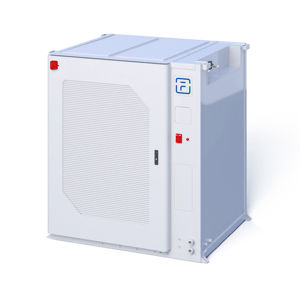Today we announced our sixth-generation technology stack, which makes implementing and operating energy storage solutions with Fluence throughout the world the simplest it's ever been. With significant advancements across the entire stack, from a modular, factory-assembled Cube to integrated controls and data-driven intelligence, this next-generation technology combines the benefits of both mass production and customization.
These advances have enabled us to drive down the non-battery costs of energy storage systems by up to 25% and enable gigawatt-scale projects. Since we began offering the sixth-generation technology a few months ago, we have already been selected for 800 MW of projects, totaling 2,300 MWh, from customers around the world including Enel, LS Power, sPower, and several customers of Siemens. Delivery for some of these projects will begin in Q4 of this year.
This modular, configurable technology stack is a significant step forward, but it is just the start of more great things to come. To further accelerate our product leadership, I am pleased to announce that Rebecca Boll has recently joined our leadership team as the company’s new Chief Product Officer. Rebecca brings a tremendous amount of experience managing both digital and hardware products at companies such as Schneider Electric and GE. Her vision and drive will help us accelerate and continue to transform the way we power our world.
Fluence's lineup of 6th generation energy storage systems, Gridstack, Sunstack, and Edgestack.
Meeting the Complex Needs of a Rapidly Growing Industry
BloombergNEF predicts the global utility and C&I energy storage markets will attract more than $560 billion in investment by 2040. That is an enormous market opportunity that we have barely begun to penetrate. To meet this scale of demand, we will need safer, cleaner, easier-to-deploy storage solutions that take the idea of net-zero carbon energy from a small market to a global reality.
To say we are on the cusp of something big would be an understatement. In fact, earlier this year, BloombergNEF predicted that more than $5 billion in deals would be announced in 2020 for renewables-plus-storage projects globally[1]. As renewable energy and storage costs are decreasing, opportunities for storage solutions — both in front of the meter and behind the meter — are becoming more widely accepted by energy providers and C&I companies. And recent successful co-location and storage-based deployments throughout the world have opened up the floodgates of opportunity for more sustainable, resilient infrastructure.
It is an exciting time to be in the energy industry, and at Fluence, we recognize that our work in the energy storage sector is central to achieving a decarbonized future. What we’ve learned from 12 years of experience building the type of storage solutions customers really need has put us in a position to truly revolutionize how storage technology and deployments can meet increasing global demand for safe, clean energy.
Energy Storage Is Appearing Everywhere
Over the past decade, energy storage has provided tremendous value in power applications such as frequency regulation, renewable integration, and replacing the need for peaking power plants. Over the next decade, energy storage use will continue to proliferate and become embedded into every single part of the electric network.
I am true believer in the concept of “virtual dams”— using energy storage to add new capabilities and revenue opportunities for non-dispatchable hydro generation. Building a dam or expanding existing hydro-power installations has significant social, economic, and environmental impacts. The ability to add battery-based energy storage can virtually expand the dam’s power generation without displacing people or damaging local ecosystems. Furthermore, many small, non-dispatchable hydro installations that could benefit from storage are in developing countries whose populations particularly need safe, reliable, and clean energy.
Energy storage is just beginning to show up in what is a massive market - deploying energy storage as “virtual transmission lines” (VTL) to add transmission network capacity faster, at lower cost and with greater benefits than traditional poles and wires projects. We recently proposed this solution for two 250-megawatt facilities in Australia, and there are even more projects like this across the world. Market operators are beginning to see the real value behind this resource and are finding ways to incorporate it in their plans.
C&I companies in sectors ranging from data centers to mining are realizing that renewables are not exclusive to utilities and are taking more control of their energy supply and demand, using solar and storage to reduce costs and meet important environmental, social, and governance (ESG) objectives.
All these applications have similarities, but each of them requires tailored packages to meet their specific needs. The needs of a virtual transmission project in Australia and a shopping center in the Nordics are significantly different. Until recently, the only two options for serving these customers were providing them with an off-the-shelf product that didn’t quite meet their needs or creating a customized system for their specific requirements. Both these approaches have drawbacks; furthermore, as storage applications continue to increase, the diverse needs of different customers increase too. So we spent the last two years developing a new approach.
I’d like to share a peek “under the hood” to give you a better idea of what we’re doing and how we are helping transform the electric power sector.
Smart Technology Stack, Simpler & Safer Deployments
 The sixth-generation Fluence technology stack is highly configurable, thanks to a factory-assembled, factory-tested and certified form factor known as the Fluence Cube. The Cube is designed such that it can accommodate a variety of battery modules in different durations from different suppliers, providing supply chain and functional flexibility. The Fluence Cubes are delivered pre-populated and can be combined with other Cubes to easily scale projects from 1 MW to 1 GW systems.
The sixth-generation Fluence technology stack is highly configurable, thanks to a factory-assembled, factory-tested and certified form factor known as the Fluence Cube. The Cube is designed such that it can accommodate a variety of battery modules in different durations from different suppliers, providing supply chain and functional flexibility. The Fluence Cubes are delivered pre-populated and can be combined with other Cubes to easily scale projects from 1 MW to 1 GW systems.
Each Cube connects to an integrated operating system (OS) that controls the overall system and enables fleet-wide system management. In fact, it’s the sophistication of the software controls we've developed over the last 12 years that enables our storage systems to bring value to such a variety of critical grid services and applications.
However, our software offers more than dynamic controls for storage assets. It is based on robust digital intelligence gleaned from one of the largest grid-scale battery-based storage datasets in the world – 230+ terabytes. The insights from this dataset are helping customers better manage battery degradation, understand how operating decisions impact an asset’s lifetime value, and optimize overall system health.
In terms of safety, we’ve fully integrated industry-leading hardware elements directly into the product, and the intelligent controls perform regular, intensive monitoring, look for system anomalies and, if necessary, trigger disconnects early before an event can progress.
This unique combination of control and autonomy are critical to improving scale and reducing cost, especially as deployments spread to more non-traditional places. The system will not only perform as delivered but also learn over time how it can best manage state of charge, balance revenue opportunities with degradation costs, and more. In turn, storage systems that continuously calculate optimal usage by knowing which application to serve and when to shift energy throughout the day will deliver more value to the grid, and to investors.
Gigawatt-Hours of Proof
It would be easy for me to talk about benefits without backing these claims up with any kind of proof. Fluence has already been selected for 800 MW, 2300 MWh, of projects using the new technology, including projects with customers such Enel, LS Power, sPower, and Siemens.
With so many years of storage expertise under our belt, Fluence has proven our technology meets the demands of industrial applications and that it’s financeable, and the market is responding. Fluence has deployed or been awarded 2.1 GW of energy storage across 100+ projects in 22 countries and territories worldwide. Combined, these projects have delivered more than 7,600 MWh of total service.
For traditional, risk-averse utilities, these levels of adoption and performance serve as critical reference points. The more success, the more decision makers realize the promise of battery-based energy storage. Early success has also opened new channels and is allowing new types of customers to finally meet their carbon reduction goals, and to do so economically.
Accelerating the Industry by Example
The energy storage industry has progressed from small system deployments in a few places to small system deployments in many places, and then to large system deployments in a few places. Now, such successful projects, falling costs, and better technology have led us to an inflection point when large systems are being deployed in many places.
Meeting the market’s increasing demand for these larger deployments requires a more scalable way of designing, manufacturing, and deploying energy storage. Our new technology stack addresses that challenge.
Fluence’s mission is to transform the way we power our world. Our business is not supplying batteries: it is helping people around the world store energy and use it whenever they need it the most. By innovating new technologies that help our customers maximize the value of energy, we are supporting the global transition from smokestacks to tech stacks that deliver a more agile, equitable, and decarbonized electric infrastructure.
[1] https://about.bnef.com/blog/energy-vehicles-sustainability-10-predictions-for-2020/
















